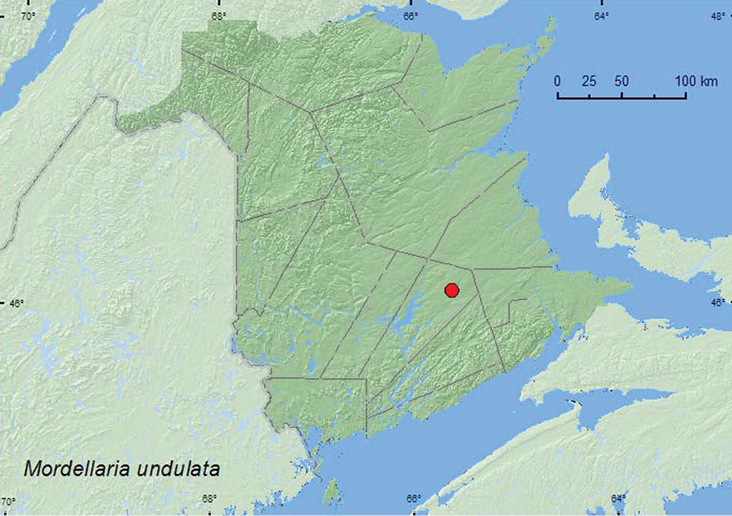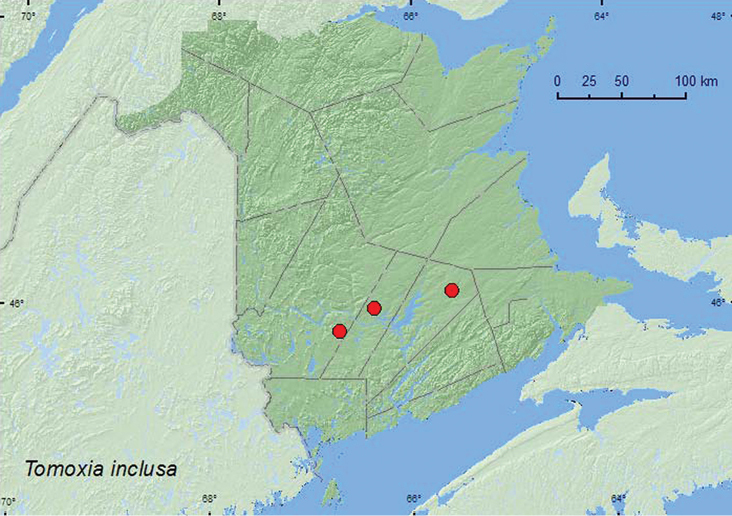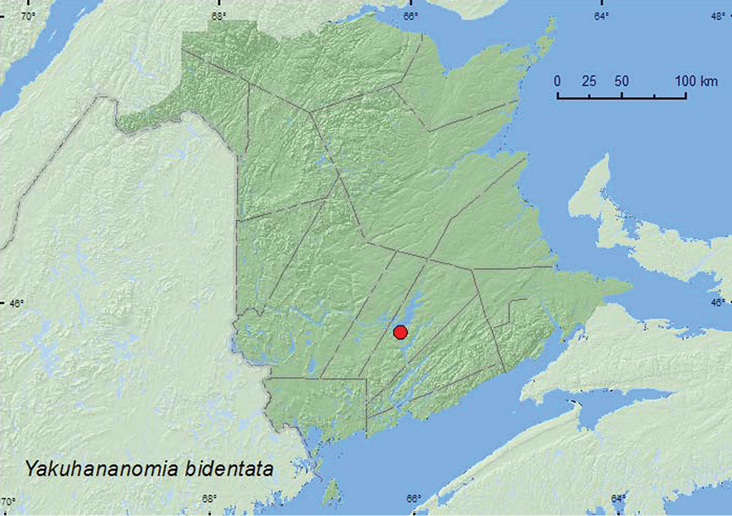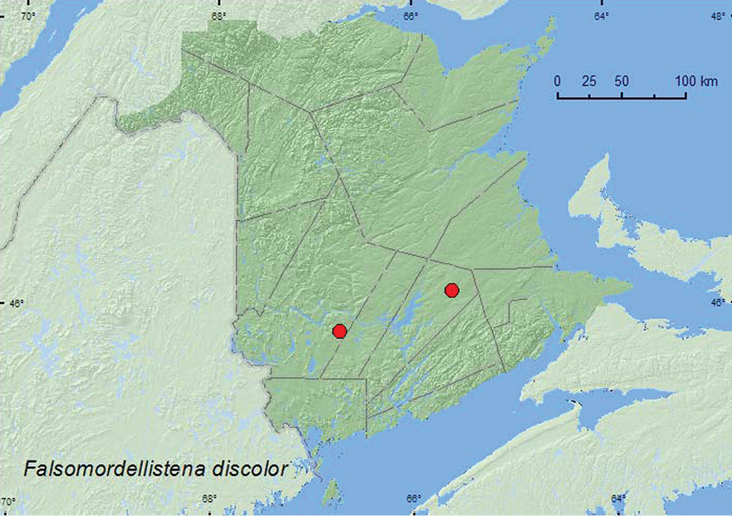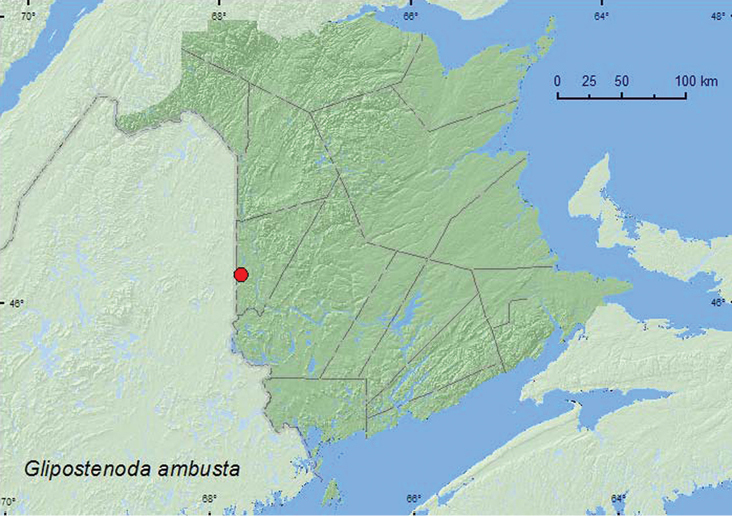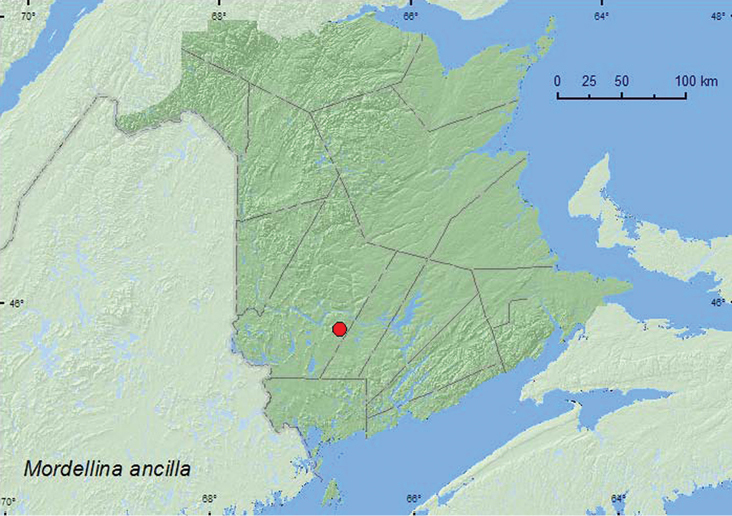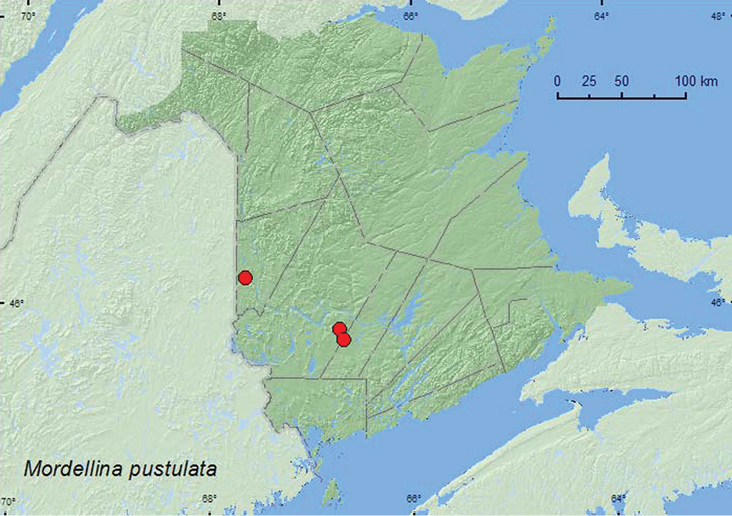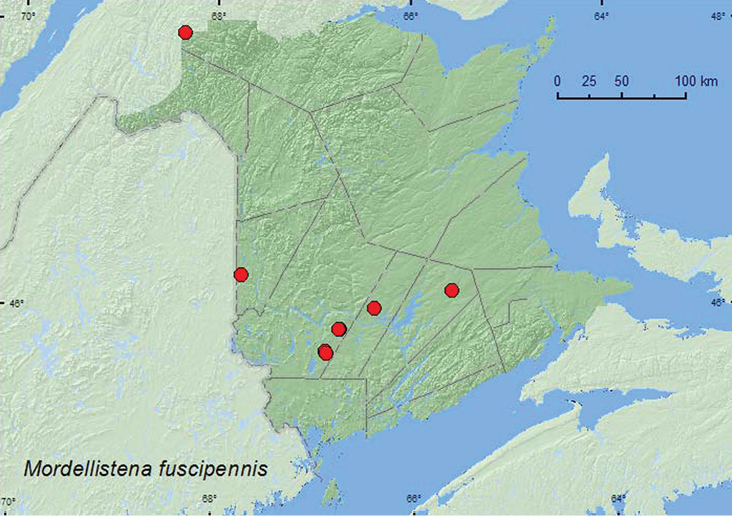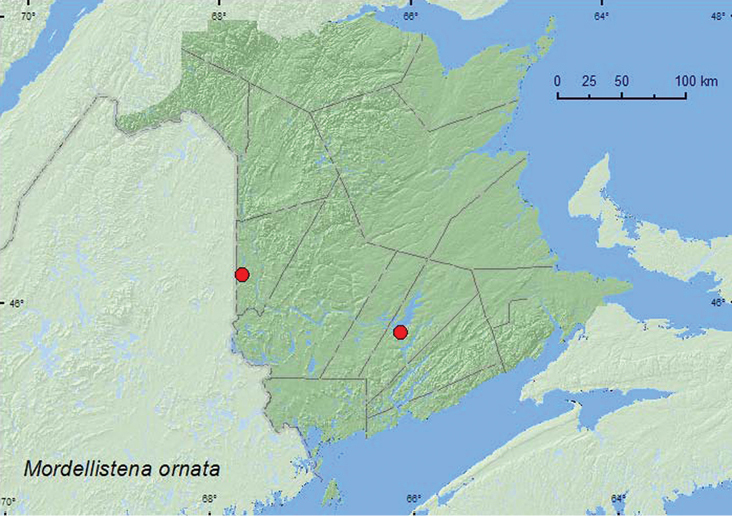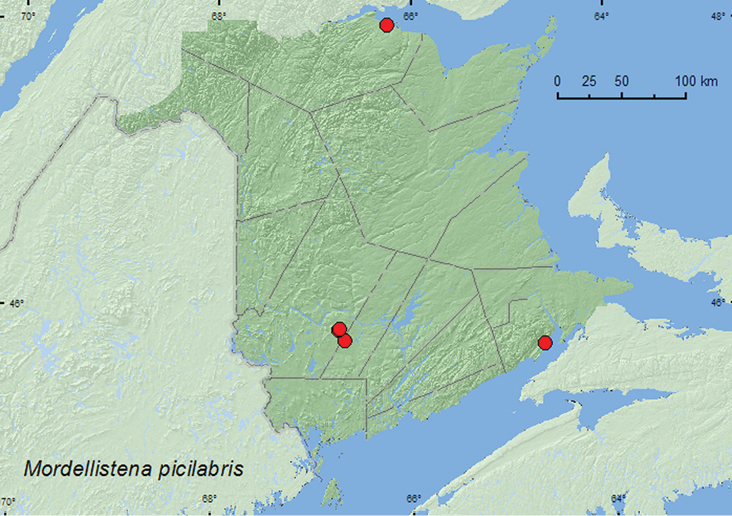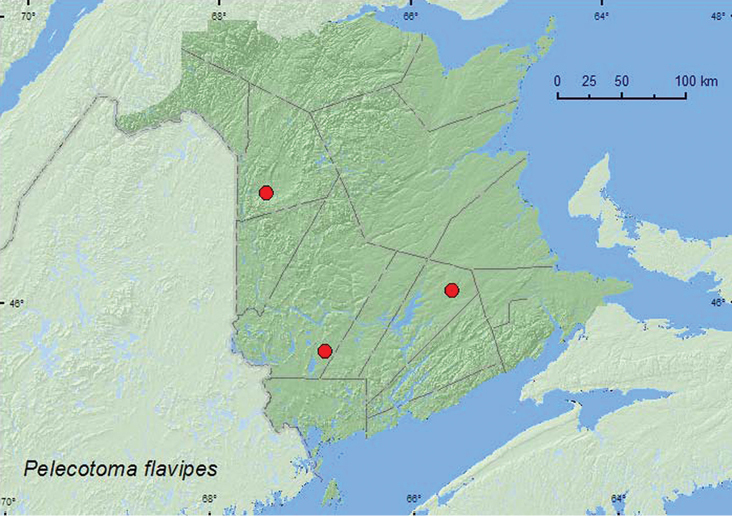






(C) 2012 Reginald P. Webster. This is an open access article distributed under the terms of the Creative Commons Attribution License 3.0 (CC-BY), which permits unrestricted use, distribution, and reproduction in any medium, provided the original author and source are credited.
For reference, use of the paginated PDF or printed version of this article is recommended.
Eleven species of Mordellidae are newly recorded for New Brunswick, Canada. Six of these, Falsomordellistena discolor (Melsheimer), Falsomordellistena pubescens (Fabricius), Mordellistena ornata (Melsheimer), Mordellaria undulata (Melsheimer), Tomoxia inclusa LeConte, and Yakuhananomia bidentata (Say)are new for the Maritime provinces. Falsomordellistena pubescens is new to Canada. Pelecotoma flavipes Melsheimer (family Ripiphoridae) is reported for the first time for New Brunswick and the Maritime provinces. Collection and habitat data are presented for all these species.
Mordellidae, Ripiphoridae, new records, Canada, New Brunswick
This paper treats new Coleoptera records from New Brunswick, Canada, of the families Mordellidae and Ripiphoridae. A general overview of the Mordellidae (tumbling flower beetles) was provided by
The following records are based on specimens collected during a general survey by the first author to document the Coleoptera fauna of New Brunswick and from by-catch samples obtained during a study to develop a general attractant for the detection of invasive species of Cerambycidae. Additional records were obtained from specimens contained in the collection belonging to Natural Resources Canada, Canadian Forest Service - Atlantic Forestry Centre, Fredericton, New Brunswick.
Collection methodsMany specimens of Mordellidae were collected by sweeping vegetation or flowers. Others were collected from Lindgren 12-funnel trap samples during a study to develop a general attractant for the detection of invasive species of Cerambycidae. These traps visually mimic tree trunks and are often effective for sampling species of Coleoptera that live in microhabitats associated with standing trees (
Distribution maps, created using ArcMap and ArcGIS, are presented for each species in New Brunswick. Every species is cited with current distribution in Canada and Alaska, using abbreviations for the state, provinces, and territories. New records for New Brunswick are indicated in bold under Distribution in Canada and Alaska. The following abbreviations are used in the text:
| AK | Alaska | MB | Manitoba |
| YT | Yukon Territory | ON | Ontario |
| NT | Northwest Territories | QC | Quebec |
| NU | Nunavut | NB | New Brunswick |
| BC | British Columbia | PE | Prince Edward Island |
| AB | Alberta | NS | Nova Scotia |
| SK | Saskatchewan | NF & LB | Newfoundland and Labrador |
Acronyms of collections examined or where specimens reside referred to in this study are as follows:
AFC Atlantic Forestry Centre, Natural Resources Canada, Canadian Forest Service, Fredericton, New Brunswick, Canada
CGMC Christopher G. Majka Collection, Halifax, Nova Scotia, Canada
CNC Canadian National Collection of Insects, Arachnids and Nematodes, Agriculture and Agri-Food Canada, Ottawa, Ontario
NBM New Brunswick Museum, Saint John, New Brunswick, Canada
RWC Reginald P. Webster Collection, Charters Settlement, New Brunswick, Canada
Results Species accountsAll records below are species newly recorded for New Brunswick, Canada. Species followed by ** are newly recorded from the Maritime provinces of Canada.
The classification of the Mordellidae and Ripiphoridae follows
Species of Tenebrionidae and Zopheridae recorded from New Brunswick, Canada.
| Family Mordellidae Latreille |
| Subfamily Mordellinae Latreille |
| Tribe Mordellini Latreille |
| Mordella atrata atrata Melsheimer |
| Mordella marginata marginata Melsheimer |
| Mordella melaena Germar |
| Mordellaria borealis (LeConte) |
| Mordellaria serval (Say) |
| Mordellaria undulata (Melsheimer)** |
| Tomoxia inclusa LeConte** |
| Tomoxia lineella LeConte |
| Yakuhananomia bidentata (Say)** |
| Tribe Mordellistenini Ermisch |
| Falsomordellistena discolor (Melsheimer)** |
| Falsomordellistena pubescens (Fabricius)*** |
| Glipostenoda ambusta (LeConte)* |
| Mordellina ancilla (LeConte)* |
| Mordellina infima (LeConte) |
| Mordellina nigricans (Melsheimer) |
| Mordellina pustulata (Mlesheimer)* |
| Mordellistena aspersa (Melsheimer) |
| Mordellistena cervicalis LeConte |
| Mordellistena errans Fall |
| Mordellistena frosti Liljeblad |
| Mordellistena fuscipennis (Melsheimer)* |
| Mordellistena indistincta Smith |
| Mordellistena limbalis (Melsheimer) |
| Mordellistena marginalis (Say) |
| Mordellistena ornata (Melsheimer)** |
| Mordellistena picilabris Helmuth* |
| Mordellistena syntaenia Liljeblad |
| Mordellistena tosta LeConte |
| Mordellistena trifasciata (Say) |
| Mordellochroa scapularis (Say) |
| Family Rhipiphoridae Gemminger |
| Subfamily Pelecotominae Seidlitz |
| Pelecotoma flavipes Melsheimer** |
| Subfamily Ripiphorinae Gemminger |
| Tribe Ripiphorini Gemminger |
| Ripiphorus fasciatus (Say) |
Notes: *New to province; **New to Maritime provinces.
Tribe Mordellini Latreille, 1802
New Brunswick, Queens Co., Cranberry Lake P.N.A. (Protected Natural Area), 46.1125°N, 65.6075°W, 4–18.VIII.2011, M. Roy & V. Webster, Lindgren funnel traps in forest canopy (2, RWC).
Collection localities in New Brunswick, Canada of Mordellaria undulata.
The adults in New Brunswick were captured in Lindgren funnel traps deployed in the forest canopy in a red oak (Quercus rubra L.) forest. Adults were collected during July and August. This species has been beaten from dead limbs of various species of hardwoods in Indiana (
ON, NB (
New Brunswick, Queens Co., Cranberry Lake P.N.A, 46.1125°N, 65.6075°W, 6.VIII.2009, M.-A. Giguère, old red oak forest, on flowers of Spiraea alba (1, AFC); same locality data and forest type, 13–20.VII.2011, M. Roy & V. Webster, Lindgren funnel trap in forest canopy (1, RWC). Sunbury Co., Acadia Research Forest, 45.9866°N, 66.3841°W, 21–29.VII.2009, R. Webster & M.-A. Giguère, mature (110-year-old) red spruce forest with scattered red maple and balsam fir, Lindgren funnel trap (1, AFC). York Co., Charters Settlement, 45.8267°N, 66.7343°W, 8.VII.2005, R. P. Webster, mixed forest, on recently cut spruce log (1, RWC); same locality and collector but 45.8331°N, 66.7410°W, 23.VII.2005, sedge marsh on flowers of Spiraea alba (1, RWC).
Collection localities in New Brunswick, Canada of Tomoxia inclusa.
Tomoxia inclusa was found in an old red oak forest, a mixed forest, and a mature red spruce (Picea rubens Sarg.) forest. Adults were collected from flowers of meadowsweet (Spiraea alba Du Roi), on a recently cut spruce (Picea sp.) log, and in Lindgren funnel traps. This species was collected during July in New Brunswick. This species has been reared from Tilia sp. (
ON, QC, NB (
New Brunswick, Queens Co., Grand Lake Meadows P.N.A., 45.8227°N, 66.1209°W, 5–19.VII.2011, 19.VII-5.VIII.2011, M. Roy & V. Webster, old silver maple forest and seasonally flooded marsh, Lindgren funnel traps in forest canopy (4, RWC).
Collection localities in New Brunswick, Canada of Yakuhananomia bidentata.
In New Brunswick, adults of this large species were captured during July and August in Lindgren funnel traps in the forest canopy in a silver maple (Acer saccharinum L.) swamp.
ON, QC, NB (
http://species-id.net/wiki/Falsomordellistena_discolor
Map 4New Brunswick, Queens Co., Cranberry Lake P.N.A, 46.1125°N, 65.6075°W, 28.VII-6.VIII.2009, R. Webster & M.-A. Giguère, old red oak forest, Lindgren funnel traps (2, RWC); same locality data and forest type, 29.VI–7.VII.2011, 7–14.VII.2011, 20.VII–4.VIII.2011, M. Roy & V. Webster, Lindgren funnel traps in forest canopy (29, AFC, NBM, RWC). York Co., Charters Settlement, 45.8300°N, 66.7347°W, 29.VIII.2004, R. P. Webster, regenerating mixed forest, on foliage (1, RWC).
Collection localities in New Brunswick, Canada of Falsomordellistena discolor.
A large series of this species was captured in Lindgren funnel traps deployed in the forest canopy of an old red oak forest. One individual was found on foliage in a regenerating (20-year-old) mixed forest. Adults were captured during July and August. In Wisconsin, this species was captured in flight intercept traps and malaise traps in sandy oak barrens and a mixed southern forest (
ON, NB (
http://species-id.net/wiki/Falsomordellistena_pubescens
Map 5Canada, New Brunswick, York Co., Rt. 645 at Beaver Brook, 45.6830°N, 66.8679°W, 8.VII.2008, R. P. Webster, red maple and alder swamp, on flowers of Ilex verticiliata (winter berry) (18, NBM, RWC).
Collection localities in New Brunswick, Canada of Falsomordellistena pubescens.
A large series of this species was collected from flowers of winter berry (Ilex verticiliata (L.) Gray) in a red maple (Acer rubrum L.) and alder (Alnus sp.) swamp. Adults were captured during early July. In Wisconsin, this species was captured in malaise traps on the margin of a southern mixed deciduous hardwood forest (
NB (new Canadian record).
New Brunswick, Carleton Co., Jackson Falls, Bell Forest, 46.2200°N, 67.7231°W, 19–28.VII.2008, R. P. Webster, mature hardwood forest, Lindgren funnel trap (1, RWC).
Collection localities in New Brunswick, Canada of Glipostenoda ambusta.
One individual of this species was captured during July in a Lindgren funnel trap in a mature hardwood forest with sugar maple (Acer saccharum Marsh.), American beech (Fagus grandifolia Ehrh.), and white ash (Fraxinus americana L.). Elsewhere,
BC, ON, QC, NB, NS (
New Brunswick, York Co., Charters Settlement, 45.8430°N, 66.7275°W, 27.VI.2004, R. P. Webster, regenerating mixed forest, sweeping foliage in brushy opening (1, RWC).
Collection localities in New Brunswick, Canada of Mordellina ancilla.
One individual of this species was swept from foliage in a brushy opening of a regenerating (20-year-old) mixed forest during late June. This species was reared from Gleditsia triacanthos L. (Fabaceae) (larvae feed inside the thorns) in Tennessee, USA (
ON, NB, NS (
New Brunswick, Carleton Co., Meduxnekeag Valley Nature Preserve, 46.1931°N, 67.6825°W, 13.VII.2004, K. Bredin, J. Edsall, & R. Webster, river margin, sweeping foliage (1, RWC). York Co., Charters Settlement, 45.8430°N, 66.7275°W, 20.VII.2008, R. P. Webster, old field within regenerating mixed forest, sweeping flowers of Aralia hispida (5, RWC); same locality data and collector but 30.VII.2008, regenerating mixed forest, sweeping foliage in brushy opening (1, RWC). Sunbury Co., ca. 2.5 km S of Beaver Dam, 45.7703°N, 66.6867°W, 26.VI.2007, R. P. Webster, mixed forest with red pine, along power-line cut, sweeping foliage (1, RWC).
Collection localities in New Brunswick, Canada of Mordellina pustulata.
In New Brunswick, Mordellina pustulata adults were swept from foliage along a river margin, in a regenerating (20-year-old) mixed forest, and along a power-line right-of-way through a mixed forest. Adults were also swept from flowers of bristly sarsaparilla (Aralia hispida Vent.) in a small old field within a regenerating (20-year-old) mixed forest. This species was collected during late June and July. Elsewhere, Mordellina pustulata has been reared from stems of Gentiana andrewsii Griseb. (Gentianaceae), Veronia altissima Nutt. (Scrophulariaceae), and 19 species of Asteraceae (
BC, AB, SK, MB, ON, QC, NB, NS (
http://species-id.net/wiki/Mordellistena_fuscipennis
Map 9New Brunswick, Carleton Co., Jackson Falls, Bell Forest, 46.2200°N, 67.7231°W, 19–28.VII.2008, 28.VII-6.VIII.2008, 6–14.VIII.2008, R. P. Webster, mature hardwood forest, Lindgren funnel traps (5, AFC, RWC); same locality and forest type, 31.VII-7.VIII.2009, 7–12.VIII.2009, R. Webster & M.-A. Giguère, Lindgren funnel trap (2, RWC). Queens Co., Cranberry Lake P.N.A, 46.1125°N, 65.6075°W, 28.VII-6.VIII.2009, 6–14.VIII.2009, R. Webster & M.-A. Giguère, old red oak forest, Lindgren funnel traps (2, AFC, RWC). Restigouche Co., Dionne Brook P.N.A., 47.9030°N, 68.3503°W, 9–23.VIII.2011, M. Roy & V. Webster, old-growth northern hardwood forest, Lindgren funnel trap (1, NBM); same locality and collectors but 47.9064°N, 68.3441°W, 28.VII-9.VIII.2011, old-growth white spruce and balsam fir forest, Lindgren funnel trap (1, NBM). Sunbury Co., Acadia Research Forest, 45.9866°N, 66.3841°W, 21–29.VII.2009, R. Webster & M.-A. Giguère, mature (110-year-old) red spruce forest with scattered red maple and balsam fir, Lindgren funnel trap (1, AFC). York Co., Charters Settlement, 45.8430°N, 66.7275°W, 28.VIII.2004, R. P. Webster, mixed forest, on goldenrod (1, RWC); same locality and collector, 45.8395°N, 66.7391°W, 23.VII.2007, 5.VIII.2009, mixed forest, u.v. light and Lindgren funnel traps (3, NBM, RWC); 15 km W of Tracy off Rt. 645, 45.6848°N, 66.8821°W, 20–29.VII.2009, R. Webster & M.-A. Giguère, old red pine forest, Lindgren funnel trap (1, AFC); 14 km WSW of Tracy, S of Rt. 645, 45.6741°N, 66.8661°W, 13–27.VII.2010, R. Webster & C. MacKay, old mixed forest with red and white spruce, red and white pine, balsam fir, eastern white cedar, red maple, and Populus sp., Lindgren funnel trap (1, AFC).
Collection localities in New Brunswick, Canada of Mordellistena fuscipennis.
In Wisconsin, adults of Mordellistena fuscipennis were collected at a black light and from flight intercept and malaise traps in various hardwood forests (
ON, QC, NB, PE, NS, (
New Brunswick, Carleton Co., Jackson Falls, Bell Forest, 46.2152°N, 67.7190°W, 12.VII.2004, K. Bredin, J. Edsall, & R. Webster, river margin, sweeping foliage (1, RWC). Queens Co., Grand Lake Meadows P.N.A., 45.8227°N, 66.1209°W, 15–29.VI.2009, R. Webster & C. MacKay, old silver maple forest with green ash and seasonally flooded marsh, Lindgren funnel trap (1, AFC).
Collection localities in New Brunswick, Canada of Mordellistena ornata.
In Wisconsin, Mordellistena ornata was collected from sumac (Rhus sp.), poplar (Populus sp.), Ceanothus sp., and flowers of two Cornus species (
SK, MB, ON, QC, NB (
New Brunswick, Albert Co., Mary’s Point, 21.V.2005, C. G. Majka, salt marsh, on flowers (1, CGMC). Restigouche Co., Blackland, 22.VIII.2007, J. S. McIvor, in grass (1, CGMC). Sunbury Co., 9.5 km NE of jct. 101 & 645, 45.7586°N, 66.6755°W, 17.VII.2008, R. P. Webster, old field with open sandy areas, sweeping foliage (1, RWC). York Co., Charters Settlement, 45.8340°N, 66.7450°W, 10.VII.2005, R. P. Webster, old field, sweeping (1, RWC); same locality and collector but 45.8430°N, 66.7275°W, 20.VII.2008, old field within regenerating (20 years-old) mixed forest, seeping flowers of Aralia hispida (1, RWC).
Collection localities in New Brunswick, Canada of Mordellistena picilabris.
In New Brunswick, Mordellistena picilabris was collected from flowers in a salt marsh, from grass, and by sweeping foliage and Aralia hispida in old fields. Adults were captured during May, July, and August.
MB, NB, NS, PE (
New Brunswick, Queens Co., Cranberry Lake P.N.A, 46.1125°N, 65.6075°W, 10–15.VII.2009, R. Webster & M.-A. Giguère, old red oak forest, Lindgren funnel traps (2, RWC); same locality data and forest type, 7–13.VII.2011, 13–20.VII.2011, M. Roy & V. Webster, Lindgren funnel traps in forest canopy (13, AFC, NBM, RWC). Victoria Co., Arthurette, (no day given).III.1959, C. C. Smith, emerged from barn timbers (1, AFC). York Co., 15 km W of Tracy off Rt. 645, 45.6848°N, 66.8821°W, 30.VI–13.VII.2010, R. Webster & K. Burgess, old red pine forest, Lindgren funnel trap (in forest canopy) (1, AFC).
Collection localities in New Brunswick, Canada of Pelecotoma flavipes.
A large series of this species was captured in Lindgren funnel traps in an old red oak forest. Most individuals were captured in traps in the forest canopy. One individual was captured in a Lindgren funnel trap in the canopy of a red pine in an old red pine forest; another emerged from barn timbers. Adults were captured during July. This species is a parasitoid of Ptilinus ruficornis (Say) (Anobiidae) and is found on exposed dead wood of sugar maples, American beech, and oak (
ON, QC, NB (
We thank Caroline Simpson for editing this manuscript and Christopher Majka and an anonymous reviewer for reviewing it. Serge Laplante (Agriculture and Agri-Food Canada (CNC), Ottawa) is thanked for determining species and other invaluable assistance. Christopher Majka is thanked for providing records of Mordellistena picilabris. We thank Nichole Brawn, Kate Bredin, Katie Burgess, Marie-Andrée Giguère, Jim Edsall, Nancy Harn, Cory Hughes, Rob Johns, Marsell Laity, Colin MacKay, Wayne MacKay, Jessica Price, Michelle Roy, Dwayne Sabine, and Vincent Webster for technical assistance and collecting specimens. Natural Resources Canada - Canadian Forest Service; the Canadian Food Inspection Agency; and the USDA APHIS are thanked for funding the study on early detection of invasive cerambycids, which provided many specimens collected in Lindgren funnel traps. We thank the New Brunswick Environmental Trust Fund and New Brunswick Wildlife Trust Fund for funding various insect surveys over the past 7 years and the Meduxnekeag River Association for permission to sample beetles at the Meduxnekeag Valley Nature Preserve (which includes the Bell Forest). The New Brunswick Department of Natural Resources (Fish and Wildlife Branch) is thanked for issuing permits for sampling in the Protected Natural Areas and for providing logistical support.
